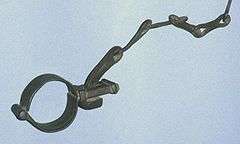Legcuffs

Legcuffs are physical restraints used on the ankles of a person to allow walking only with a restricted stride and to prevent running and effective physical resistance.[1]
Frequently used alternative terms are leg cuffs, (leg/ankle) shackles, footcuffs, fetters[2] or leg irons. The term "fetter" shares a root with the word "foot".
With respect to humans, shackles are typically used on prisoners and slaves. Leg shackles also are used for chain gangs to keep them together.[3]

Metaphorically, a fetter may be anything that restricts or restrains in any way, hence the word "unfettered".
History

The earliest fetters found in archaeological excavations date from the prehistoric age and are mostly of the puzzle lock type. Fetters are also referenced in ancient times in the Bible.
In the Scriptures the Hebrew word necho′sheth, usually meaning "copper," is frequently translated "fetters of copper" or "copper fetters," because fetters were often made of copper or bronze, although wood and iron were also employed. (2Sa 3:34; 2Ki 25:7) In the British Museum there is a pair of bronze fetters from Nineveh (the capital city of ancient Assyria) in the form of a bar with a ring at each end.[4]

Roman times already see a variety of restraint types. Some early versions of cup lock shackles can already be found. These were widely used in medieval times but their use declined when mass production made the manufacture of locks built into restraints affordable.
Simple fetter types continue to be used like puzzle lock shackles as the typical slave iron or irons riveted shut for prisoners being transported to overseas prison camps.
The first built-in locks often were of a simple screw-type but soon developed into the "Darby" type. In Europe these continued to be used into the middle of the 20th century, whereas in the U.S. from the late 19th century onwards many new designs were invented and produced before handcuffs and leg irons of the Peerless type became the standard several decades ago.
Controversial use
In comparison to handcuffs the wearing of leg irons may be found less restrictive. Thus the prison authorities in several countries deem their long-term use acceptable. In order to avoid condoning this disputed practice, the countries of the European Union have banned exporting leg irons into non-EU countries.[5][6] The countries that continue to make prisoners wear fetters long term now tend to resort to manufacturing their own restraints.
See also
References
- ↑ "Select Your Library - Credo Reference".
- ↑
 Chisholm, Hugh, ed. (1911). "Fetters and Handcuffs". Encyclopædia Britannica. 10 (11th ed.). Cambridge University Press. p. 296.
Chisholm, Hugh, ed. (1911). "Fetters and Handcuffs". Encyclopædia Britannica. 10 (11th ed.). Cambridge University Press. p. 296. - ↑ Reynolds, Marylee. "Back on the Chain Gang". Corrections Today. Gale group. Archived from the original on May 21, 2011. Retrieved 1 October 2013.
- ↑ Insight on the Scriptures Vol. 1 pp. 350-352 (Bond)
- ↑ Civilising the torture trade, by Steve Wright, The Guardian, Thursday March 13, 2003
- ↑ COUNCIL REGULATION (EC) No 1236/2005 of 27 June 2005, concerning trade in certain goods which could be used for capital punishment, torture or other cruel, inhuman or degrading treatment or punishment